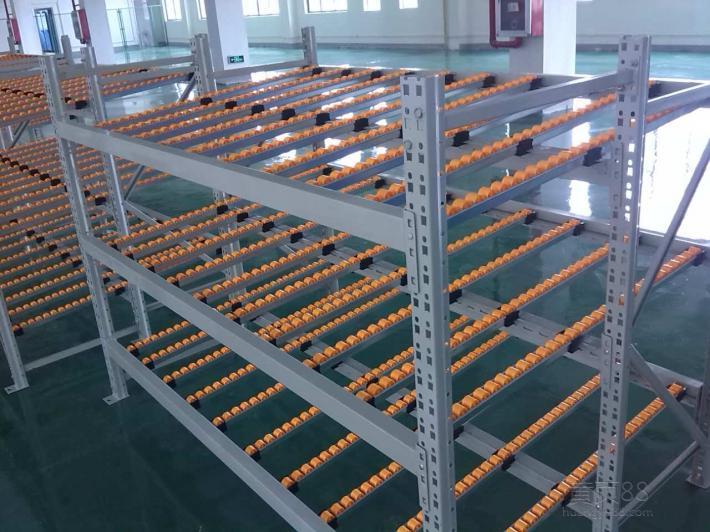Alright, warehouse managers and operations folks, let's talk about a real game-changer: Flow Racking. You know the drill. Picking feels slow, space is always tight, and the hunt for that one SKU buried in the back of a static shelf? Yeah, it kills productivity and morale. If you're serious about streamlining your inventory management and getting orders out the door faster, Flow Racking isn't just nice to have – it's essential. But not all systems are created equal. Let's break down the absolute must-haves to ensure your Flow Racking investment delivers maximum efficiency and a serious ROI.
1. The Right Design & Configuration: It's Not One-Size-Fits-All
Jumping straight into buying Flow Racking without a solid plan is like throwing darts blindfolded. You gotta get this part right.
- Deep Dive on Your Inventory: This is step zero. What are your fastest-moving SKUs (your "A" items)? What's their size, weight, and cube? How many pallets or cartons do you typically handle per SKU? Flow Racking shines brightest for high-velocity items with consistent turnover. Trying to force slow-movers into Flow Racking lanes? That's a recipe for wasted space and capital.
- Pick Your Lane Style: Gravity reigns supreme, but how?Pallet Flow: The heavy lifter. Built for full pallet loads rolling on heavy-duty rollers or wheels. Perfect for bulk storage and full-pallet picking. Think beverages, large packaged goods.Carton Flow: The pick-face superstar. Designed for cases moving on skate wheel or roller tracks. Ideal for broken-case picking (each-pick) operations in distribution centers. Think e-commerce fulfillment, retail replenishment.
- Lane Depth & Pitch: How many units deep can your lane be? This depends on your inventory velocity and the physical space. Too deep, and your oldest stock gets stuck at the back (hello, potential obsolescence!). Too shallow, and you're constantly replenishing, defeating the purpose. The angle (pitch) of the tracks is crucial – it needs enough gravity to move your specific product smoothly without causing damage from excessive speed. Getting this wrong is a common pitfall.

2. High-Quality, Application-Specific Tracks & Rollers: The Heart of the Flow
This is where the magic (or the misery) happens. The rolling surface is the core of any Flow Racking system. Skimp here, and you'll pay dearly in downtime and frustration.
- Pallet Flow: You need serious muscle.Heavy-Duty Rollers: For very heavy loads or uneven-bottomed pallets, rollers provide superior support and smoother movement. They handle the abuse.Wheel Rails: Often a more cost-effective option for standard pallets, offering good speed and lower friction. Ensure the wheel spacing and size match your typical pallet base.
- Carton Flow: Precision and gentleness are key.Skate Wheel: The most common and versatile. Provides low friction for smooth carton movement. Choose wheel diameter and spacing based on your smallest carton size to prevent jams. Nylon wheels are quiet; steel handles heavier loads.Roller Tracks: Ideal for heavier, more rigid cartons or items prone to catching on wheels. Offers a more stable ride. Spool rollers are great for preventing line contact with labels.
- Material Matters: Galvanized steel is standard and durable. Stainless steel is the premium choice for cold storage, food-grade, or corrosive environments. Don't forget the importance of braking systems (end brakes, lane dividers with brakes) to control product speed, especially at the pick face or on steeper inclines. Safety first!
3. Robust Lane Dividers & End Stops: Keeping Order in the Chaos
Without proper containment, your beautiful FIFO (First-In, First-Out) Flow Racking lane turns into a jumbled mess. This is non-negotiable for efficient inventory management.
- Lane Dividers: These physically separate each SKU lane. They must be:Sturdy Enough: To withstand constant product impact and forklift nudges (accidents happen!).High Enough: To prevent products from jumping lanes during flow, especially during braking.Compatible: Seamlessly integrate with your chosen track/roller system and braking components.
- End Stops: The final barrier at the pick face. Critical for:Stopping Power: Safely halting the product where the picker needs it.Product Protection: Preventing damage from impact.Security: Keeping product securely in the lane until picked. Look for designs that are easy for pickers to reach over or around. End stops often incorporate the final braking mechanism.
4. Safety Features: Protecting Your People and Product
Efficiency means nothing if it compromises safety. Flow Racking introduces specific hazards that must be addressed head-on.
- Load Backstops: Absolutely essential for pallet flow lanes! This heavy-duty barrier sits at the rear (loading end) of the lane. Its job? Prevent the entire column of pallets from surging forward when the front pallet is removed. A runaway pallet column is incredibly dangerous. Don't even think about operating pallet flow without these.
- Column Guards: Protect the upright support columns from forklift impacts. Let's be real, forklifts hit things. Guards prevent costly damage to the structural integrity of your entire Flow Racking system.
- Clear Signage: Label lanes clearly with SKU information and capacity limits. Mark the loading and picking ends distinctly.
- Proper Training: This is paramount. Operators loading the lanes must understand how to place pallets/cartons correctly, how the braking works, and the critical role of load backstops. Pickers need training on safe removal techniques and awareness of moving loads.
5. Seamless Integration with Your Overall Operation
Your Flow Racking system doesn't exist in a vacuum. It's a key component of your broader warehouse inventory management strategy.
- Replenishment Strategy: How will stock get into the Flow Racking lanes? Is there clear access from receiving or bulk storage? Efficient replenishment is vital to keep pick faces full. Flow Racking only works if lanes are stocked correctly and promptly.
- Picking Process Fit: Does the Flow Racking layout align with your picking paths? Is the pick face at an ergonomic height? Carton flow lanes feeding pack stations need logical flow. Pallet flow for full-pallet orders needs clear access for forklifts.
- Warehouse Management System (WMS) Compatibility: For optimal inventory control and efficiency, your WMS should track inventory stored in the Flow Racking lanes. This enables accurate real-time stock visibility, directs put-away and replenishment efficiently, and optimizes picking routes. Know exactly what's in each lane and how deep it is.
- Future-Proofing: Consider potential growth or changes in SKU profile. Can the system be easily reconfigured? Is adding more lanes straightforward? Choose a flexible Flow Racking solution.

6. Quality Installation & Professional Assessment: Don't DIY This
Flow Racking is a significant investment. Getting it installed correctly is crucial for performance, safety, and longevity.
- Professional Site Survey: Have experts assess your space, floor conditions (levelness is critical for proper gravity flow!), ceiling height, existing infrastructure, and specific product characteristics. They can model the best configuration.
- Experienced Installers: Proper installation ensures structural integrity, correct pitch, alignment of tracks, and secure mounting of all components. A sloppy install leads to jams, poor flow, safety risks, and premature wear. This isn't the time for shortcuts.
- Supplier Reputation & Support: Choose a supplier known for quality components, reliable engineering, and excellent customer service. You want someone who will be there for maintenance advice, replacement parts, or system expansions down the line. Ask for references!
The Bottom Line: Why These Must-Haves Matter
Investing in Flow Racking without focusing on these critical elements is like buying a sports car with cheap tires – you won't get the performance or safety you paid for. Getting the right Flow Racking system, tailored to your specific needs and equipped with these must-haves, delivers tangible results:
- Dramatically Faster Picking: Minimize travel and search time. Product comes to the picker.
- True FIFO Inventory Rotation: Eliminate hidden old stock, reduce spoilage (especially crucial for perishables), and improve stock accuracy.
- Massive Space Savings: Store more product in the same footprint compared to static shelving, thanks to dense storage and elimination of aisles within the lane.
- Reduced Labor Costs: Faster picking and easier replenishment mean you get more done with the same team (or handle growth without adding headcount as fast).
- Enhanced Safety: Properly designed and installed Flow Racking with safety features minimizes key warehouse hazards associated with manual stock searching and improper material flow.
- Improved Ergonomics: Less bending, reaching, and walking for pickers means less fatigue and fewer injuries.
- Scalability: A well-designed Flow Racking system can grow and adapt with your business.
Wrapping It Up: Flow Racking Done Right = Efficiency Unleashed
Look, efficient inventory management is the backbone of a profitable warehouse or distribution center. Flow Racking is one of the most powerful tools you have to achieve that efficiency, but only if you implement it correctly. Ignoring these must-haves – the right design, top-quality tracks/rollers, essential containment and safety features, seamless operational integration, and professional installation – is setting yourself up for headaches and a system that doesn't deliver on its promise.
Do your homework, partner with reputable experts, invest in quality components, and prioritize safety. When you nail these Flow Racking essentials, you unlock a whole new level of speed, accuracy, and space utilization.


 Wechat
Wechat
 Whatsapp
Whatsapp